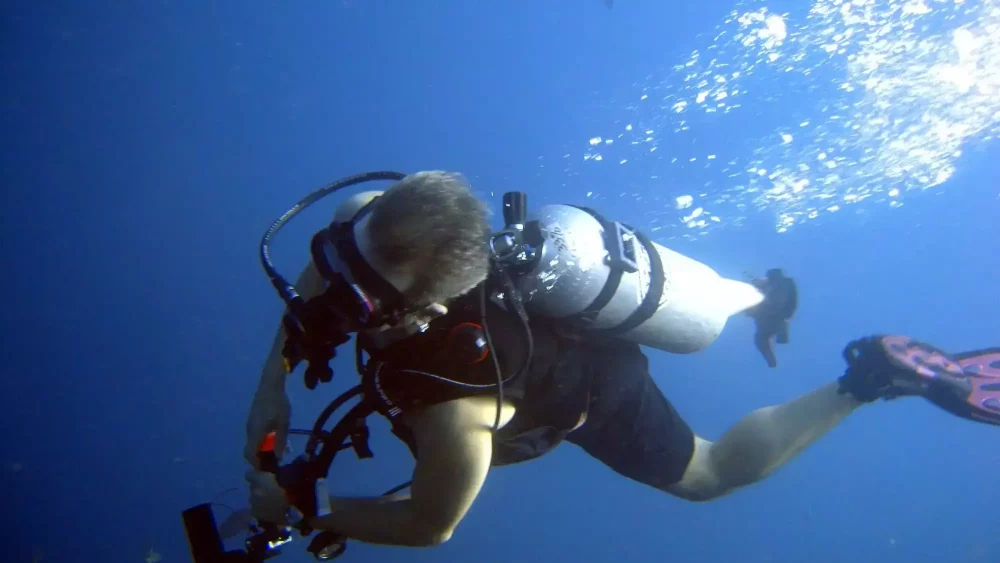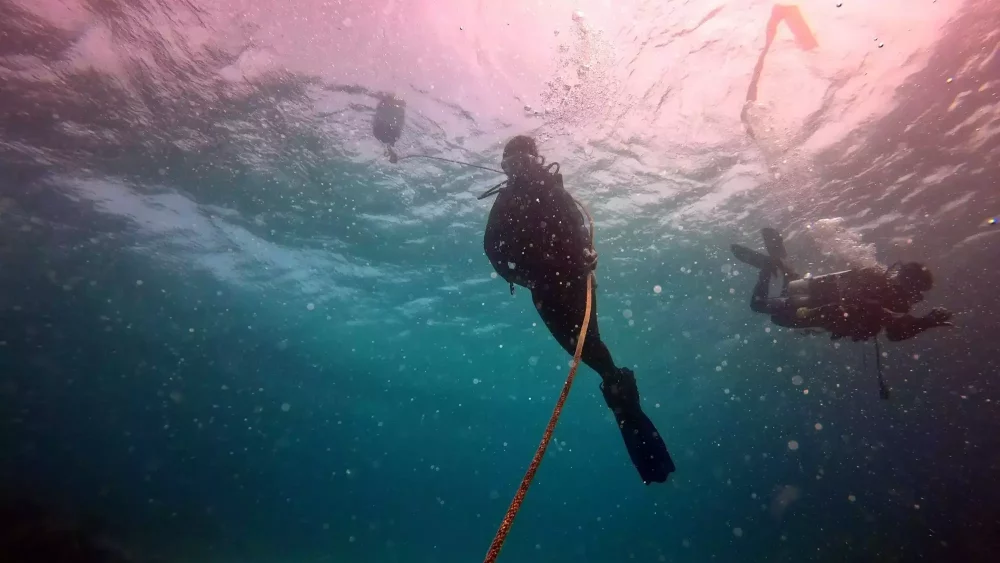Scuba diving is an incredible journey, and the right gear can make all the difference in ensuring your comfort and safety underwater. Whether you’re an experienced diver preparing for exams, a beginner about to take your first plunge, or someone curious about the world of scuba, this guide will provide you with comprehensive knowledge about the essential scuba equipment. Let’s explore the world of scuba gear, so you can truly “Dive Like a Pro.”
1. Mask
Why it’s important: A properly fitting mask is essential for a clear view of the underwater world. It creates an air pocket in front of your eyes, allowing you to see underwater without your eyes coming into contact with the surrounding water.
What to look for:
- Comfortable fit: Ensure it seals comfortably against your face without causing discomfort or leaving marks.
- Field of vision: Opt for a mask with a wide field of view.
- Low volume: A low-volume mask is easier to clear and reduces the need for equalization.
2. Snorkel
Why it’s important: A snorkel allows you to breathe at the surface without wasting air from your tank. It’s handy for surface swims and conserves your tank’s air supply.
What to look for:
- Comfortable mouthpiece: Choose a snorkel with a flexible and comfortable mouthpiece.
- Purge valve: A one-way purge valve makes clearing water from the snorkel easier.
- Flexibility: Look for a flexible snorkel that can be easily stowed when not in use.
3. Fins
Why they’re important: Fins improve your underwater mobility, making it easier to move efficiently and conserve energy.
What to look for:
- Fit: Ensure they fit snugly but not too tight, with no uncomfortable pressure points.
- Blade design: Consider the type of diving you’ll be doing – split fins for efficiency or paddle fins for power.
- Material: Choose between full-foot fins (for warm-water diving) or open-heel fins (ideal for cold-water or multi-environment diving).
4. Wetsuit or Drysuit
Why it’s important: Exposure protection is crucial for staying warm underwater. A wetsuit or drysuit helps maintain your body temperature in the water.
What to look for:
- Fit: A snug, well-fitting suit is essential for maintaining insulation.
- Thickness: Choose the right thickness for the water temperature you’ll be diving in.
- Material: Neoprene is the most common wetsuit material, while drysuits are made from various materials, including trilaminate and crushed neoprene.
5. Regulator
Why it’s important: The regulator is your lifeline underwater. It reduces the high-pressure air in your tank to a breathable level and ensures you have a continuous air supply.
What to look for:
- Reliability: Opt for a reputable brand known for high-quality regulators.
- Comfort: Ensure the mouthpiece is comfortable and fits well.
- Easy maintenance: Choose a regulator that is easy to clean and service.
6. Buoyancy Control Device (BCD)
Why it’s important: The BCD helps you control your buoyancy underwater, allowing you to ascend, descend, and stay at a specific depth.
What to look for:
- Fit: Select a BCD that fits comfortably and doesn’t restrict movement.
- Lift capacity: Choose one with enough lift for your body weight and any extra weight you’ll be carrying.
- Integrated weight system: Look for a BCD with integrated weight pockets for convenience.
7. Dive Computer
Why it’s important: A dive computer is like having a personal dive planner on your wrist. It tracks your depth, time, and decompression status, enhancing safety and reducing the need for tables and charts.
What to look for:
- Display: Ensure the display is easy to read in various underwater conditions.
- Functionality: Select a model that suits your diving needs, whether you’re a beginner or an experienced diver.
- Safety features: Look for features like audible alarms, ascent rate indicators, and Nitrox compatibility.
8. Tank
Why it’s important: The tank stores the air you breathe underwater. Choosing the right tank is crucial for safety and comfort.
What to look for:
- Material: Opt for tanks made of corrosion-resistant materials, such as aluminum or steel.
- Size: Choose a tank size that matches your diving needs and the duration of your dives.
- Proper maintenance: Ensure your tank is regularly inspected and properly filled.
9. Weight System
Why it’s important: A weight system helps you achieve neutral buoyancy underwater by offsetting your buoyancy with added weight.
What to look for:
- Weight capacity: Ensure your weight system can hold the necessary weight for buoyancy control.
- Quick-release system: Choose a weight system with a quick-release mechanism for safety.
10. Dive Light
Why it’s important: A dive light is crucial for exploring the underwater world, especially in low-light conditions. It helps you reveal the vibrant colors and intricate details of marine life.
What to look for:
- Waterproof and durable: Select a light that can withstand the pressure and moisture of the underwater environment.
- Battery life: Choose a model with a battery life suitable for your dive duration.
- Rechargeable: Consider a rechargeable dive light to save on battery costs and environmental impact.
11. Dive Knife
Why it’s important: A dive knife is a safety tool for cutting through lines or freeing yourself from entanglements. It’s an essential piece of equipment for safety and peace of mind.
What to look for:
- Compact design: Choose a dive knife that is easy to access and use underwater.
- Corrosion-resistant material: Opt for a knife made of materials that can withstand saltwater exposure.
12. Surface Marker Buoy (SMB)
Why it’s important: An SMB helps make your presence known at the surface, especially in drift or boat dives. It enhances safety by signaling your location to boats and other divers.
What to look for:
- Compact and easy to inflate: Ensure your SMB is easy to deploy and inflate, even in challenging conditions.
- High visibility: Choose a brightly colored SMB for maximum visibility.
13. Compass
Why it’s important: A compass aids navigation underwater, helping you find your way and maintain your course.
What to look for:
- Easy to read: Select a compass with easy-to-read markings and a luminescent face.
- Adjustable bezel: An adjustable bezel allows you to set your course and navigate effectively.
14. First Aid Kit
Why it’s important: Safety is a top priority in scuba diving. A dive-specific first aid kit is essential for handling minor injuries and being prepared for emergencies.
What to look for:
- Dive-specific items: Ensure your kit contains items specifically designed for dive-related injuries and situations.
- Compact and waterproof: A compact, waterproof kit is easy to stow and protect your first aid supplies from moisture.
15. Dive Bag
Why it’s important: A dive bag keeps your gear organized, easy to transport, and helps protect it from damage.
What to look for:
- Durability: Choose a bag made of strong, water-resistant material to protect your gear during travel and storage.
- Compartments: Look for a bag with multiple compartments to keep your gear organized.
16. Environmentally Friendly Sunscreen
Why it’s important: Protect yourself from the sun’s harmful rays while also protecting the marine environment by choosing sunscreen that is eco-friendly and safe for reefs.
What to look for:
- Reef-safe: Choose sunscreen labeled as “reef-safe” to minimize environmental impact.
- Broad-spectrum protection: Ensure your sunscreen offers broad-spectrum protection against UVA and UVB rays.
17. Environmental Responsibility
Why it’s important: Every diver should practice environmentally responsible behaviors. Always follow the principles of “Leave No Trace” underwater, respecting marine life and their habitats.
What to remember:
- Avoid touching or damaging coral reefs.
- Do not collect or disturb marine life.
- Properly dispose of trash and plastics to prevent pollution.
- Participate in underwater clean-up efforts to help preserve our oceans.
In conclusion, by understanding and selecting the right scuba gear, you can embark on your underwater adventures with confidence and safety. Whether you’re an experienced diver preparing for exams, a beginner about to take your first dive, or someone simply interested in the world of scuba, this guide equips you to “Dive Like a Pro.” So, gear up, dive in, and experience the wonders of the underwater realm responsibly and sustainably.

